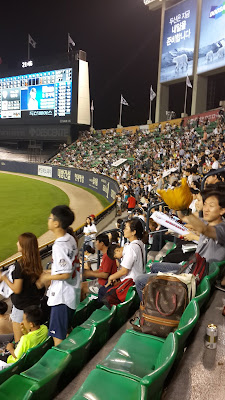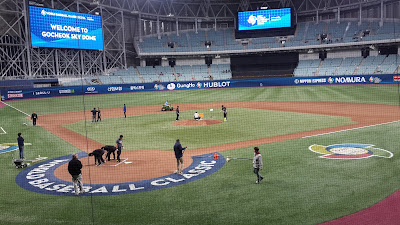The signs all proclaimed that we should "Rise Up!" when I traveled up to attend Opening Day at Munhak Stadium, home of the SK Wyverns, on March 24, 2018.
Maybe they were just trying to keep us warm.
 With Code Red pollution levels, a murky haze covering the surrounding mountains, and temperatures beginning at 48℉ (9℃) and then dropping to 45℉ (7℃) with wind chill as the game wore on, it was challenging, to say the least. But I arrived early, in my bulky fleece and cloth face mask, with hand warmers at the ready, and was ready to go with a bucket of fried chicken to warm my insides. The saleswoman even gave me a free water to go with my food.
With Code Red pollution levels, a murky haze covering the surrounding mountains, and temperatures beginning at 48℉ (9℃) and then dropping to 45℉ (7℃) with wind chill as the game wore on, it was challenging, to say the least. But I arrived early, in my bulky fleece and cloth face mask, with hand warmers at the ready, and was ready to go with a bucket of fried chicken to warm my insides. The saleswoman even gave me a free water to go with my food.The 2018 KBO season was an oddity, the longest in the league's history, with rain and "fine dust level" (pollution) cancellations during the course of the spring and summer. The league took a break from August 16 to Sept. 3 for the Asian Games, necessitating the March opening, and played long into mid-November. It was also the year that I got really serious with my Korean baseball quest, knowing I wanted to catch a game in all nine stadiums. I ticked off three more in 2018.
 Pollution is a significant condition people face here in the Land of the Morning Calm, and it's a significant one with far-reaching health and mental ramifications. I have gotten into the habit, for the first time in my life, while living here, of checking pollution-tracking apps on my phone. I also have come to understand that when I look out my window in the mornings and see fog-like conditions, that this is usually ... maddeningly ... NOT fog.
Pollution is a significant condition people face here in the Land of the Morning Calm, and it's a significant one with far-reaching health and mental ramifications. I have gotten into the habit, for the first time in my life, while living here, of checking pollution-tracking apps on my phone. I also have come to understand that when I look out my window in the mornings and see fog-like conditions, that this is usually ... maddeningly ... NOT fog.Note: one by-product of the 2020 Covid situation is that for the first time, since I've been here, I've noticed blue skies and have actually gotten out of the habit of checking these aforementioned phone apps (which read a solid green most of the time).
But back to March 24, 2018.
Interestingly enough, and completely unknowable to me with my chicken bucket, sitting in frigid Munhak Stadium (also known by the ridiculously overwrought sponsorship name "Incheon SK Happy Dream Park"), I was watching the first step on a very long triumphal 2018 road for the Wyverns, who marched all the way through the next 7+ months to an eventual KBO championship, beating the Doosan Bears. On Nov. 12, the fightin' Wyverns claimed the team's fourth title in history.
 Munhak is large (25,000 fans eventually drifted in to fill the place during that game), but the place looked a bit "beat-up." The field had all the appearances of an early-spring "just coming out of winter" look (with dirt patches here and there and a kind of unkempt appearance) but I appreciated the energy the fans brought, and my eyes kept wandering over to the left field outfield area, where tents were set up, and people were picnicking and having a grand old time in the chill. But I would be lying if I told you that I wasn't also constantly looking up with amazement at the solid wall of "fog-not-fog" that surrounded all of us.
Munhak is large (25,000 fans eventually drifted in to fill the place during that game), but the place looked a bit "beat-up." The field had all the appearances of an early-spring "just coming out of winter" look (with dirt patches here and there and a kind of unkempt appearance) but I appreciated the energy the fans brought, and my eyes kept wandering over to the left field outfield area, where tents were set up, and people were picnicking and having a grand old time in the chill. But I would be lying if I told you that I wasn't also constantly looking up with amazement at the solid wall of "fog-not-fog" that surrounded all of us.The Wyvern energy was there even as I came in to the stadium area, walking up to the ballpark from the subway (it had taken me at least an hour to get out to Incheon from Seoul), and I soaked in the sea of red banners (capturing various players in their pitching or batting glory) and settled in to my seat to a plethora of announcements and huzzahs as the game got started. I still get into the expectant buzz before a game has begun, and hey, Opening Day is still Opening Day, even if it's late March.
 With all that said, I'm going to be perfectly honest here. I only made it five innings in Munhak, before the bitter chill got to me on that day. When I left the game, the home dragons were ahead of the visiting Lotte Giants, 5-4, and they would eventually win a close one, 6-5. The Wyvern's starter Merrill Kelly (a mainstay for a few years with the team before he signed with Arizona in 2019) struck out 10 in five innings, but left the game when I did, so he was denied the win. Five innings is technically a game, and I rarely leave any game, but in hindsight I should have brought gloves and a winter hat. Others were clearly feeling the same; the crowd had thinned.
With all that said, I'm going to be perfectly honest here. I only made it five innings in Munhak, before the bitter chill got to me on that day. When I left the game, the home dragons were ahead of the visiting Lotte Giants, 5-4, and they would eventually win a close one, 6-5. The Wyvern's starter Merrill Kelly (a mainstay for a few years with the team before he signed with Arizona in 2019) struck out 10 in five innings, but left the game when I did, so he was denied the win. Five innings is technically a game, and I rarely leave any game, but in hindsight I should have brought gloves and a winter hat. Others were clearly feeling the same; the crowd had thinned.The enticements of Incheon city were calling me like a siren into the remainder of the evening. The stadium is a bit inland but not far from the port area, where most of the action is. Incheon is just west of Seoul, and is home to the country's airport, and there are myriad subway lines, trains and buses that connect the two. Incheon also has a significant historical Chinatown area, and it's there that I eventually found the statue of Douglas MacArthur, who of course is famous for liberating the place from the North Koreans with his daring invasion from the sea in 1950. After all this time, he is still remembered, standing tall in a park above the hubbub of Chinatown.
 But back to mighty Munhak and the Wyverns. I always appreciate a good angry dragon (and the Wyvern fulfills that role nicely although they seem to have some owl and a knight running around the stadium too) and a team that plays itself into contention more often than not. The expansion team Wyverns have generally done this in the last few years, even though they are off to a wretched start in 2020. After a particularly painful 10-game losing streak, and a balky bullpen and defensive miscues, they are solidly in last place this season.
But back to mighty Munhak and the Wyverns. I always appreciate a good angry dragon (and the Wyvern fulfills that role nicely although they seem to have some owl and a knight running around the stadium too) and a team that plays itself into contention more often than not. The expansion team Wyverns have generally done this in the last few years, even though they are off to a wretched start in 2020. After a particularly painful 10-game losing streak, and a balky bullpen and defensive miscues, they are solidly in last place this season.Third baseman Choi Jeong, who was batting third that day and who drove in the first two runs with a solid single, really came into his own in 2016 (he has been with the team since 2005) as he started wailing on the ball (he hit over 40 homers and lead the league in home runs both years from 2016 to 2017). In 2018, he "only" managed 35 long balls. Canadian first baseman Jamie Romak joined the team in 2017, and has since hit more than 100 home runs. The Wyverns also boasted a fairly formidable pitching rotation that year with Kelly, Angel Sanchez (now with the Yomiuri Giants), and longtime Wyvern Kim Kwang Hyun (now in St. Louis!)
I always found it a little odd how the Wyverns managed to win in 2018, as their team stats were awful (a recent check of the league's website confirmed this). Their batting average (.233) was last in the league, and their team ERA was an unenviable 5.21 (third from the bottom). But they did pull in over a million fans for the season, so they had the support. Somehow ranked second at season's end, they gutted out a five-game victory over Nexen, and then took on the Bears, beating them in six games, the final win coming on the road at Jamsil. So they earned it. Good on them. Three of their four championships, by the way, have been at the expense of the Doosan Bears.

Historically, the team has had a decent amount of success as they've only been around since 2000 (just before World Cup mania hit Japan and Korea). During that year, the Hyundai Unicorns, who would eventually dissolve, left Incheon and moved to Suwon. The league decided it was time to award SK Telecom a team, and the SK corporate leadership saw the vacancy and put the team in the Incheon area. The Wyverns' team colors, appropriately enough for that Opening Day 2018 and for all pollution-challenged games, are orange and red, loud colors in a loud bat-flip league.
Too bad the team is struggling this year. Perhaps the Wyverns need a few more "dust level" cancellations, a nine-month season, and they'll right back in it.
---
We're through five innings at this point (technically a complete game!), and we've got four more stadiums to go. Next up, we head southeast to Daegu, to one of the original teams of the league, the Samsung Lions.




















